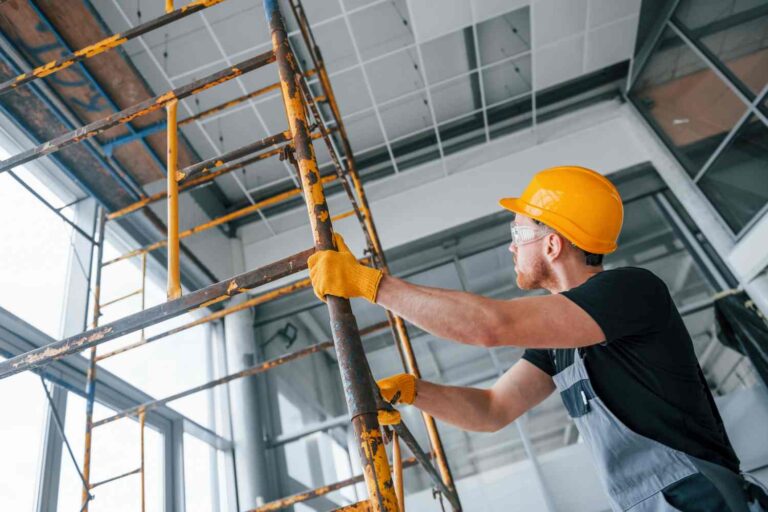- 17 September 2024
- 4 min read
Fundamentals of scaffolding

Table of contents
How to plan a scaffolding structure?
Planning a scaffolding structure involves several critical steps to ensure safety and efficiency. The scaffolding basics are as follows: First, assess the requirements of the project, including the intended tasks, necessary height, and load capacity, which includes the weight of workers, materials, and tools. Evaluate the site for potential hazards such as uneven terrain, overhead obstructions, and environmental conditions like wind and weather.
Choose the type of scaffolding—supported, suspended, or mobile—based on these assessments and the specific needs of the project. Design the scaffold with precise dimensions and configurations, including platforms, ladders, and safety features like guardrails. It’s essential to consult with a structural engineer for complex designs and to use high-quality, inspected materials.
Ensure that the plan complies with local safety regulations and standards. Implement the scaffolding with a clear assembly and disassembly sequence, handled by a trained team.
Basic scaffolding components and their installation
Basic scaffolding components include standards, ledgers, and transoms, which form the structure’s framework. Standards are vertical tubes that transfer the entire weight of the structure to the ground, where base plates are placed to distribute the load and minimize sinking. Ledgers run horizontally and connect the standards, providing lateral support. Transoms are placed perpendicular to the ledgers, supporting the decking or platforms where workers stand.
Scaffolding best practices for installation – first ensure a level and firm foundation to set up the base plates and casters if the scaffold is mobile. Connect the standards to the base plates and secure them with ledgers at predetermined intervals. Attach transoms at right angles to the ledgers to support the platforms. Diagonal braces are then installed for additional stability, connecting the standards at various angles to prevent the scaffold from swaying.
Platforms are laid down on the transoms, ensuring they are secure and cover the area without gaps that could pose a hazard. Safety features like guardrails and toe boards are added around the perimeter of the platforms to prevent falls and dropped objects.
Before use, a thorough inspection by a competent person is essential to confirm the scaffold’s stability and safety. Regular inspections should continue throughout the scaffold’s use to address any potential issues early.
Scaffold erection techniques
Erecting scaffolding safely involves careful planning and precise assembly techniques. Start by preparing a stable base using base plates or casters set on firm ground. Build the base frame with the first set of standards (vertical poles) and ledgers (horizontal poles). Continue adding standards, ensuring they’re vertical, and connect them with ledgers at regular intervals for horizontal support. Attach transoms across the ledgers to support platforms and distribute the load and install diagonal braces for lateral stability. Lay platforms securely on the transoms, ensuring they are stable and closely spaced. Add guardrails and toe boards at all open sides to prevent falls and secure the structure. Before use, have the scaffold inspected by a competent person to confirm its stability and safety. Regular inspections should be maintained throughout the scaffold’s use, especially after modifications or severe weather events. Proper training and adherence to safety standards are crucial for maintaining a secure work environment.
The most common mistakes when installing scaffolding and how to avoid them
The most common mistakes when installing scaffolding include improper foundation setup, inadequate bracing, incorrect platform construction, and neglecting safety checks. To avoid these errors:
- Ensure stable foundations
- Adequate bracing
- Secure platform construction
- Regular safety checks
Summary
Scaffolding is crucial in construction, providing temporary support for workers and materials at height. It comes in supported, suspended, and mobile forms, typically made from steel, aluminum, or wood. Safety regulations mandate that scaffolds support their weight plus four times the intended load, with necessary guardrails for heights above 10 feet. Qualified personnel must supervise installation and conduct regular inspections and maintenance. Planning involves assessing project needs, site hazards, and choosing the right scaffolding type. Adhering to safety standards throughout the project is essential for a secure work environment.
You might be interested in...
- Building advice
- DIY

17 September 2024
Mounting your TV on the wall – all what you need to know!
Mounting your TV on the wall offers a sleek, space-saving solution, but it requires proper planning and execution. From selecting the right mount type and ensuring VESA compatibility to finding the perfect spot and safely installing the bracket, each step is crucial. This guide covers everything you need to know, including tools, installation steps, cable management, and troubleshooting tips, ensuring a secure, stylish setup for your home.
- Building advice
- DIY

17 June 2024
Applying wallpaper on a chimney breast – a how-to guide
Wallpapering a chimney breast can transform your room’s focal point into a striking feature. Begin by measuring the chimney breast’s width and height to calculate how much wallpaper you’ll need. Choose a durable, heat-resistant wallpaper suitable for high temperatures. Ensure the surface is clean, dry, and smooth; repair any flaws before you start. Apply an even layer of adhesive directly to the wall. Align the first strip at the center of the chimney breast, smoothing it outwards to avoid air bubbles. Repeat with additional strips, ensuring the patterns match. Trim excess wallpaper at the edges for a neat finish.
- Building advice
- Renovation advice

17 September 2024
The cost of a new kitchen – what expenses do you have to take into account?
When planning for a new kitchen, several key expenses need consideration. These include cabinetry, appliances, countertops, flooring, and installation. Additionally, you should factor in costs for lighting, plumbing, and finishing touches. Each of these components varies widely in price based on quality, materials, and customization. It’s important to get detailed quotes and plan for contingencies to ensure your budget covers all aspects of the renovation.